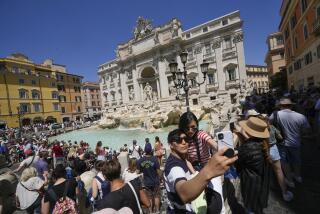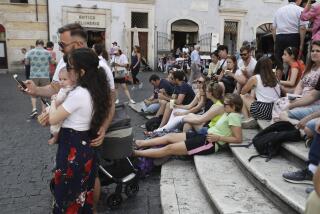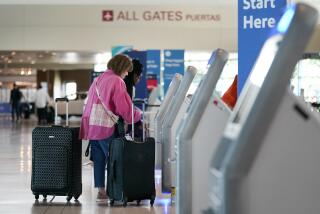Ways to Get More Bang From Your Buck in Europe : Currencies: Consumers need to be savvy to stretch their dollars on the continent. Using package tours and public transportation can help.
- Share via
Wait! Before you get on that plane to Europe and the Continent begins to gobble your shrinking dollars like a hungry boar, consider a few preventive measures. Here are half a dozen, pulled together with the help of Frederique Raeymaekers, chairman of the European Travel Commission, and Ed Perkins, editor of the Consumer Reports Travel Letter.
Package tours: Package-tour companies deal in large volumes (which is a great source of savings to begin with) and negotiate their rates several seasons ahead so that most of this summer’s package tours are being sold at rates negotiated in 1994, when the dollar was stronger in most of Europe. Four of the largest operators of tours for Americans in Europe are Globus-Gateway and its more affordable sibling Cosmos-Tourama, Trafalgar Tours, Insight International Tours and Brendan Tours. (Most major tour operators take bookings only through travel agents.)
This year, with the dollar weakening against the German mark and some other European currencies, some tour companies have taken the unusual step of hiking their catalogue prices by as much as 7%--but even after such an increase, the package prices are likely to be better than an individual traveler could find on his or her own.
If you can’t stand the idea of traveling as part of a herd, keep in mind that most tour operators offer minimal packages that include just air fare and hotels, and perhaps a rental car too. One company that specializes in flexible packages for independent travelers is New York-based Travel Bound. Most of the largest, most reliable tour operators belong to the U.S. Tour Operators Assn.
Half-off lodging programs: Many people already use these programs for dining out in their hometowns. Membership-booklet programs typically cost $50-$100 yearly in exchange for a booklet of coupons for 50% savings at participating hotels. Among the largest programs: Entertainment Publications (800-445-4137), whose Entertainment Europe Hotel Directory costs $53 and includes roughly 750 European hotels; the Great American Travel Directory (800-548-2812), which costs $49.95 and includes more than 400 European hotels; the Privilege Card (800-236-9732), which costs $75 and covers “several hundred” hotels in Europe and elsewhere.
Itinerary planning: Lodging and lots of other things cost more in capital cities. So if you’ve seen London and Paris and Rome before, this could be the time to concentrate on a country agenda: the Cotswolds in England, for instance, or Normandy in France, or Tuscany in Italy. (If you do want to concentrate on big cities, look out for culture bargains. Many cities offer multiple-museum passes and free concerts and other performances in churches, squares and public parks are common.)
Eating: If your lodgings payment also covers breakfast, load up on whatever is offered, the better to skimp on lunch. If breakfast is not included, then get out of the hotel and find a local cafe. (Even on a modest breakfast, that maneuver alone can save $5-$10 per person.) Whenever possible, buy bread, cheese and fruit, etc. at local markets, and take picnic lunches in public parks. And finally, for those big-city restaurant lunches and dinners, get a few blocks off the beaten tourist and business travelers’ track before you sit down to eat. Never eat any place where most of your fellow customers seem to be on an expense account. Also, adds Raeymaekers, “Drink the beverage of the area--beer in beer country, wine in wine country.”
Currency and credit: If you pay with a credit card whenever possible, your dollars will be traded for foreign currency at the preferred exchange rate that major financial institutions enjoy--a better rate than is offered to individuals by any bank or exchange office. (Of course, if you don’t pay off your credit-card debt promptly, you’ll lose your money to the cards’ hefty interest rates, which can run up to 19% annually.) For those occasions when you need cash, consider getting it from an automated teller machine in Europe that’s affiliated with your system at home. Every year, thousands more ATMs are installed around the Continent in connection with Star, Plus or other systems. Using them gets you those preferred exchange rates that banks and others get. Before you leave the United States, ask the issuer of your card for a list of international ATM sites.
Getting around the city: Flee from taxis. Instead, take advantage of Europe’s public transportation networks, which are generally superior to those in the United States. Take the bus, or subway or local train. On a transfer from airport to city center, taking public transportion can easily save you $30. If you’re staying more than a day or two, consider a multi-day transit pass, which most cities make available.
Getting around from city to city: Mile for mile, flying within Europe can cost far more than flying within the United States, which leaves many travelers puzzling over whether they should rent a car or take the train. That depends on what countries you’re visiting, what month it is and whether you can find cheap parking, among other things. Another factor is the recent rise in European rental rates. Still, Ed Perkins of Consumer Reports concludes that for a traveling couple facing a one-week, 1,000-mile itinerary, a subcompact rental car is a more affordable option in most of Europe--except Italy, where rail service is unusually cheap. Remember, though, the more miles you put in, the more you’re at the mercy of Europe’s much higher gasoline costs. (The May issue of the Consumer Reports Travel Letter will include a detailed analysis, and any issue of the $39-a-year monthly newsletter will be useful to a frugal traveler. Subscription information: 800-234-1970.)
More to Read
Sign up for The Wild
We’ll help you find the best places to hike, bike and run, as well as the perfect silent spots for meditation and yoga.
You may occasionally receive promotional content from the Los Angeles Times.







